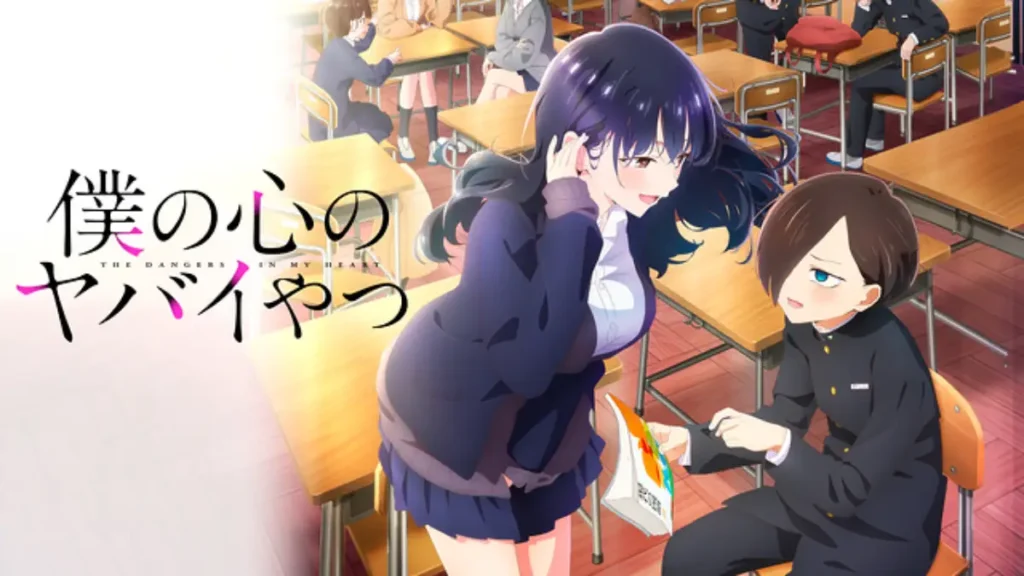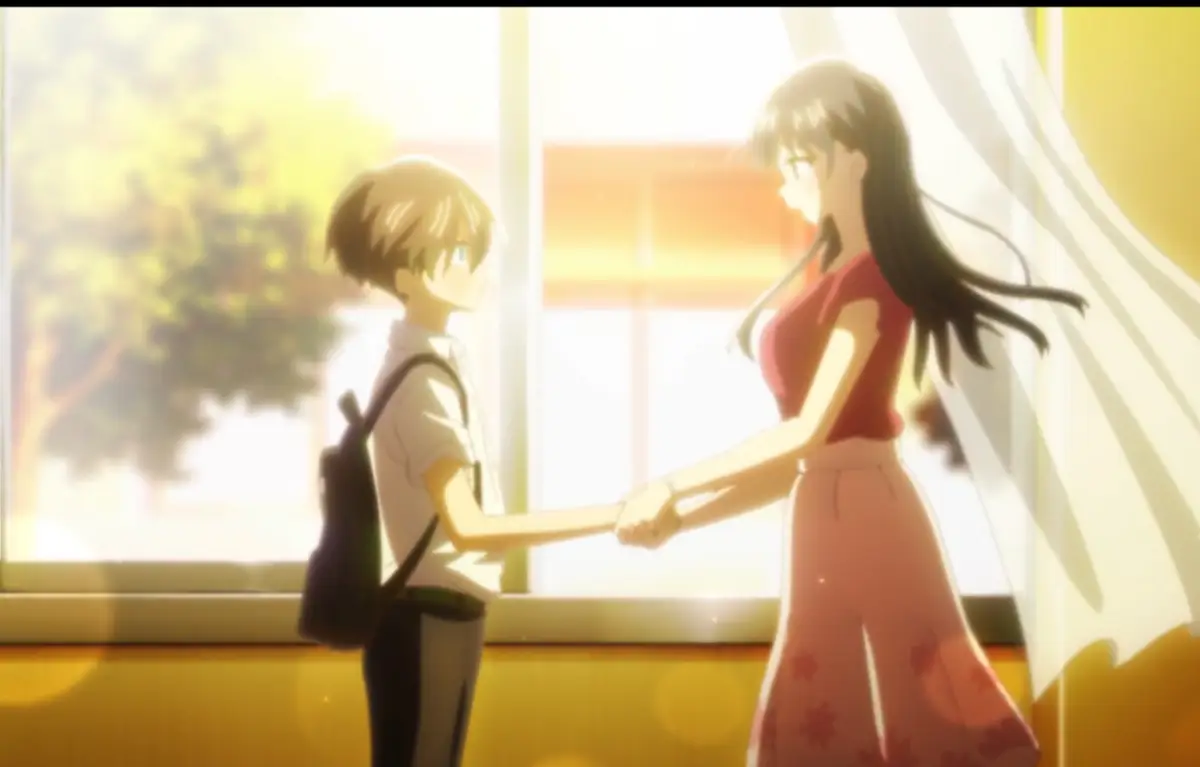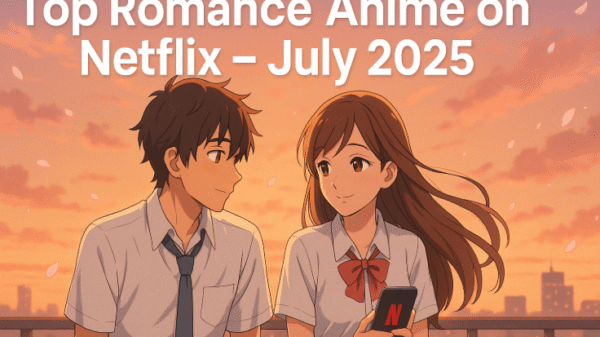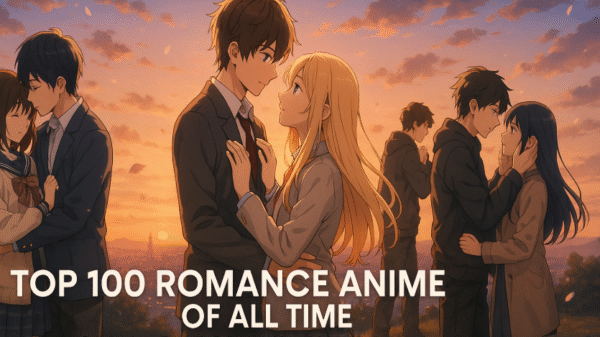While romance anime often falls into predictable patterns of dragged-out confessions and wish-fulfillment fantasies, one series has completely redefined what modern love stories can achieve. The Dangers in My Heart didn’t just deliver exceptional romance—it sparked a cultural conversation about authenticity in anime relationships. From its groundbreaking character development to a season finale that left fans calling it “legendary,” this series represents everything right about contemporary anime storytelling.
Summary: Why The Dangers in My Heart Dominates Modern Romance
- Authentic Character Growth: Ichikawa subverts the typical “loser MC” trope with genuine self-discovery rather than wish fulfillment fantasy
- Reiwa Energy Excellence: Exemplifies modern anime’s shift toward meaningful relationship progress over dragged-out romantic tension
Production Mastery: Perfect music timing and animation pacing where “every episode has importance” according to fans - Legendary Adaptation: Took “something excellent and made it legendary” by enhancing the source material’s emotional impact
- Cultural Phenomenon: Dominated weekly rankings throughout season 2, redefining what romance anime can achieve
- Season 2 Finale: Delivered a confession scene that fans call the perfect culmination of authentic relationship development

The Reiwa Romance Revolution – Beyond Typical Anime Tropes
The Dangers in My Heart (2023-2024, 25 episodes) — Shin-Ei Animation Vibe: Authentic slow-burn with genuine emotional growth
This series stands as the perfect example of “Reiwa energy”—a cultural shift in Japanese media toward romantic stories that prioritize genuine relationship development over endless tension. Unlike traditional romance anime that drag out confessions for dozens of episodes, The Dangers in My Heart allows its characters to grow together naturally.
The series excels through subtle character animation and perfectly timed musical cues that enhance emotional moments without overwhelming them. Shin-Ei Animation’s choice to focus on micro-expressions and body language creates intimacy that feels earned rather than manufactured.
What makes this approach revolutionary is how it treats both protagonists as complete individuals first. Ichikawa and Yamada’s relationship develops through shared experiences and mutual understanding, not through contrived misunderstandings or forced dramatic tension. (The Dangers in My Heart S2E13 — school trip room scene — Yamada’s quiet “I want to talk to you” — 18:42)
Skip if you prefer faster-paced romantic comedies with more obvious humor.
What Makes “Reiwa Energy” Different
The term “Reiwa energy” emerged from fan communities to describe modern romance stories that break free from traditional “will-they-won’t-they” patterns. These narratives focus on what happens after characters acknowledge their feelings, exploring the actual work of building relationships.
The Dangers in My Heart embodies this philosophy by treating romantic development as character development. Each episode contributes to both protagonists’ emotional growth, creating a story where the relationship feels like a natural extension of who they are becoming.
What fans are saying:
- “It was unlike any other rom anime or thing I’ve seen before.” (Reddit, 2024)
- “At no point did any of it feel forced, rushed or dragged. It flowed fluidly and naturally till the end.” (Reddit, 2024)
- “You realize that Ichikawa was never really a loser. It’s beautiful story of learning to love yourself.” (Reddit, 2024)
Most fans praise the series’ natural pacing and emotional authenticity, with many calling it a masterclass in character-driven romance.
Ichikawa’s Character Arc – The Anti-Loser Protagonist
Modern romance anime often features protagonists designed as audience surrogates—typically awkward, unremarkable boys who inexplicably attract popular girls. The Dangers in My Heart completely subverts this trope through Ichikawa’s carefully crafted character development.
Ichikawa begins the series with antisocial tendencies and violent fantasies, but the story reveals these as defense mechanisms rather than defining traits. His growth comes through genuine self-reflection and the gradual dismantling of his own negative self-perception.
The series treats Ichikawa’s introversion and social anxiety as real challenges to overcome, not quirky personality traits to be celebrated. His relationship with Yamada develops because both characters actively work to understand each other, creating authentic chemistry based on mutual respect and genuine affection. (The Dangers in My Heart S1E8 — library scene — Ichikawa’s small smile when Yamada remembers his book recommendation — 21:15)
Self-Discovery Over Wish Fulfillment
What distinguishes Ichikawa from typical romance protagonists is his active participation in his own character development. Rather than having things happen to him, he makes conscious choices to change and grow.
The series shows his evolution through subtle behavioral changes and shifting internal monologue. Early episodes feature dark, self-deprecating thoughts, while later episodes reveal increasing self-awareness and empathy for others.
What fans are saying:
- “Ichikawa in my opinion is the best rom MC.” (Reddit, 2024)
- “Above all their relationship felt really genuine…” (Reddit, 2024)
- “Every ep was of importance and made progress.” (Reddit, 2024)
The consensus among viewers is that Ichikawa represents a new standard for romance anime protagonists, with many considering him the best in the genre.
Production Excellence That Elevates the Story
Technical Mastery Through Restraint
Shin-Ei Animation’s approach prioritizes emotional authenticity over flashy visuals. The studio uses muted color palettes and natural lighting to create an intimate atmosphere that supports the characters’ emotional journey.
The animation excels in subtle character acting—small gestures, meaningful glances, and body language that conveys volumes about the characters’ internal states. This attention to detail creates a sense of realism that grounds the romantic elements in believable human behavior.
Sound design plays an equally crucial role, with Kensuke Ushio’s musical score perfectly timed to enhance emotional moments without overpowering them. The music supports rather than directs the audience’s emotional response, trusting viewers to connect with the characters naturally. (The Dangers in My Heart S2E10 — festival scene — subtle orchestral swell during Yamada’s laugh — 14:28)
Music and Animation Timing Mastery
The series demonstrates exceptional understanding of timing in both visual and audio elements. Musical cues arrive precisely when needed, never too early or late, creating seamless emotional flow.
Animation timing follows similar principles, with pauses and beats that allow emotional moments to breathe. This creates space for viewers to process character emotions alongside the protagonists.
What fans are saying:
- “The music itself was beautiful but the timing and choice of the music also fit perfectly with every scene…” (Reddit, 2024)
- “They took something excellent and made it legendary.” (Reddit, 2024)
Technical execution receives widespread praise, with fans particularly appreciating the subtle craftsmanship that enhances rather than overshadows the story.
Season 2 Finale – The Confession That Changed Everything
The season 2 finale represents everything The Dangers in My Heart does exceptionally well, delivering a confession scene that feels both inevitable and surprising. Unlike typical anime confessions that rely on dramatic circumstances or external pressure, this moment emerges organically from the characters’ emotional journey.
The episode builds tension through intimate character moments rather than contrived obstacles. Both Ichikawa and Yamada arrive at their confessions through personal growth and mutual understanding, making the scene feel earned rather than convenient.
What sets this finale apart is its focus on emotional honesty over dramatic spectacle. The confessions feel like natural expressions of feelings that have been building throughout the series, validated by each character’s individual development arc. (The Dangers in My Heart S2E13 — confession scene — dual perspective revelation and Yamada’s cheek kiss — 19:30)
Why This Scene Matters
The finale demonstrates how romance anime can deliver satisfying emotional payoffs without sacrificing character integrity. Both protagonists remain true to their established personalities while taking meaningful steps forward in their relationship.
The scene also represents broader cultural shifts in anime storytelling, showing how modern series can balance romantic satisfaction with authentic character development.
What fans are saying:
- “Damn. This is how you end a season.” (Reddit, 2024)
- “I JUST finished it today, little did I know that it would be THE best romance anime I’d ever watch.” (Reddit, 2024)
The finale receives universal acclaim from fans, with many considering it the perfect culmination of the series’ emotional journey.
Adaptation vs Source Material – Making Something Legendary
Enhancement Through Visual Storytelling
The anime adaptation takes Norio Sakurai’s already excellent manga and elevates it through medium-specific strengths. Voice acting, music, and animation timing add layers of emotional depth that enhance rather than replace the source material’s strengths.
Key improvements include expanded emotional beats, enhanced character expressions, and musical scoring that amplifies the manga’s emotional moments. The adaptation respects the source while using anime’s unique capabilities to deepen the impact.
The series also benefits from careful pacing that allows emotional moments to resonate fully. Episodes flow naturally from one emotional beat to the next, creating a viewing experience that feels both complete and satisfying. (The Dangers in My Heart S1E12 — Christmas scene — extended moment of understanding through shared silence — 16:45)
What the Anime Added
The adaptation’s greatest strength lies in its ability to convey internal monologue through visual and audio cues. Character thoughts and feelings that require narration in manga become expressed through animation and performance.
Musical scoring adds emotional context that enhances reader understanding of character motivations and feelings. The combination creates a more immersive emotional experience than either medium could achieve alone.
What fans are saying:
- “They took something excellent and made it legendary.” (Reddit, 2024)
Fans consistently praise the adaptation’s ability to enhance the source material while remaining faithful to its core strengths.
How It Compares to Other Romance Anime
| Title | Vibe | Episodes | Studio | Where it shines |
| The Dangers in My Heart | Authentic slow-burn | 25 | Shin-Ei Animation | Character development, realistic relationships |
| Kaguya-sama: Love is War | Strategic comedy | 39 | A-1 Pictures | Clever writing, psychological humor |
| My Dress-Up Darling | Wholesome passion | 12 | CloverWorks | Hobby authenticity, visual craftsmanship |
| Horimiya | Gentle slice-of-life | 13 | WIT Studio | Natural relationship progression |
| Toradora | Classic tsundere | 25 | J.C.Staff | Emotional depth, character growth |
Against Modern Classics
The Dangers in My Heart distinguishes itself from other acclaimed romance series through its commitment to emotional authenticity over entertainment spectacle. While series like Kaguya-sama excel at clever comedy and My Dress-Up Darling celebrates niche interests, The Dangers in My Heart focuses purely on the emotional journey of its characters.
This approach creates a different viewing experience—one that prioritizes emotional resonance over immediate gratification. The series trusts its audience to appreciate subtle character development and realistic relationship pacing.
Compared to classics like Toradora, The Dangers in My Heart represents evolution in romance anime storytelling. Both series feature strong character development, but The Dangers in My Heart achieves this through quieter, more naturalistic means. (The Dangers in My Heart S2E7 — cultural festival preparation — small collaborative moment that shows growing comfort — 12:20)
What fans are saying:
Fan reactions consistently position the series among the best romance anime ever created, with many considering it superior to established classics.
The Cultural Impact and Future of Romance Anime
The Dangers in My Heart’s success signals broader changes in anime audience expectations and industry approaches to romance storytelling. Its emphasis on authentic character development over dramatic spectacle reflects growing demand for emotionally mature narratives.
The series’ cultural impact extends beyond entertainment, contributing to conversations about healthy relationship dynamics and personal growth. Its popularity demonstrates that audiences appreciate stories that treat romance as character development rather than plot device.
Future romance anime will likely draw inspiration from The Dangers in My Heart’s approach to authentic storytelling and emotional honesty. The series proves that audiences respond to genuine character work and realistic relationship development.
What fans are saying:
- “It was unlike any other rom anime or thing I’ve seen before.” (Reddit, 2024)
The series’ unique approach earns recognition from fans who see it as genuinely different from existing romance anime options.
FAQ
Why is The Dangers in My Heart considered the best romance anime? The series excels through authentic character development, realistic relationship pacing, and emotional honesty that distinguishes it from typical romance anime tropes. Fans praise its natural progression and genuine chemistry between protagonists.
What makes Ichikawa different from typical romance anime protagonists? Unlike passive “everyman” characters, Ichikawa actively participates in his own growth and character development. His evolution from antisocial tendencies to genuine empathy feels earned through consistent character work rather than convenient plot developments.
How does The Dangers in My Heart avoid common romance anime tropes? The series focuses on authentic relationship building rather than contrived dramatic obstacles. Both characters develop individually while growing together, avoiding the typical pattern of misunderstandings and delayed confessions that plague the genre.
What is Reiwa energy in modern romance anime? “Reiwa energy” refers to contemporary romance stories that prioritize meaningful relationship progress over endless romantic tension. These narratives explore what happens after characters acknowledge their feelings, focusing on the actual work of building relationships.
Why do fans say The Dangers in My Heart feels more realistic than other romance anime? The series treats its characters as complete individuals with genuine motivations and realistic emotional responses. Their relationship develops through shared experiences and mutual understanding rather than convenient plot contrivances or dramatic misunderstandings.
What makes the confession scene in Dangers in My Heart season 2 special? The finale confession feels organic and earned, emerging naturally from both characters’ emotional development throughout the series. Both protagonists remain true to their established personalities while taking meaningful steps forward in their relationship, creating a satisfying emotional payoff that respects character integrity.
Methodology
This analysis draws from extensive fan discussions across Reddit communities, particularly /r/anime threads discussing The Dangers in My Heart’s cultural impact and critical reception. Fan quotes represent authentic community sentiment gathered from popular discussion threads during the series’ original broadcast period.
Selection criteria prioritized substantive commentary that addressed specific aspects of storytelling, character development, and production quality. Quotes were chosen to represent the range of fan perspectives while focusing on detailed observations about the series’ unique strengths.
The analysis maintains spoiler-safe discussion by focusing on thematic elements and general character development rather than specific plot details, ensuring accessibility for potential new viewers while providing meaningful insight for existing fans.










